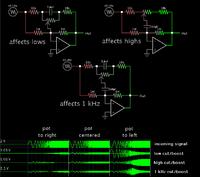T3STY
Full Member level 4
Some time ago I was looking for some ready-made band pass filter circuit that would be able to boost/cut the band. I found then a circuit which works just fine (simulated in ISIS), but I can't understand the logic behind of it because the author didn't explain it. Here's the link to the page where I found the circuit:
http://www.next.gr/audio/equalizers/octave-equalizer-circuit-l14813.html
A part from telling me anything I should know about it, my questions are:
1) Is this a multiple feedback design?
2) Where are the filters? I mean, I can't identify the components that actually make the filter while I still know that C1 and C2 are part of it.
3) If my suppositions are right, the feedback circuit is itself a filter. How does it impact on the whole?
4) Why does changing the value of R2 make the filter boost or cut, without affecting the band pass filter itself?
5) What do the 1MOhm resistors (R3) do? Placed there like this seem to have no particular purpose for the filter but changing their values to 10kOhm for example in ISIS would mess up everything; either the filter won't work at all or it would "work" but I would hear noises only.
6) How may I calculate the component values for a specific frequency? I know there are 10 bands already calculated, but it's for my personal interest.
7) What is (or how may I calculate) the bandwidth of this filter? The same for the Q factor.
I know I'm asking a lot.. actually, everything.. but please, I'm really interested in understanding this circuit.
Thanks to anyone who'll be answering!
http://www.next.gr/audio/equalizers/octave-equalizer-circuit-l14813.html
A part from telling me anything I should know about it, my questions are:
1) Is this a multiple feedback design?
2) Where are the filters? I mean, I can't identify the components that actually make the filter while I still know that C1 and C2 are part of it.
3) If my suppositions are right, the feedback circuit is itself a filter. How does it impact on the whole?
4) Why does changing the value of R2 make the filter boost or cut, without affecting the band pass filter itself?
5) What do the 1MOhm resistors (R3) do? Placed there like this seem to have no particular purpose for the filter but changing their values to 10kOhm for example in ISIS would mess up everything; either the filter won't work at all or it would "work" but I would hear noises only.
6) How may I calculate the component values for a specific frequency? I know there are 10 bands already calculated, but it's for my personal interest.
7) What is (or how may I calculate) the bandwidth of this filter? The same for the Q factor.
I know I'm asking a lot.. actually, everything.. but please, I'm really interested in understanding this circuit.
Thanks to anyone who'll be answering!
Last edited:
